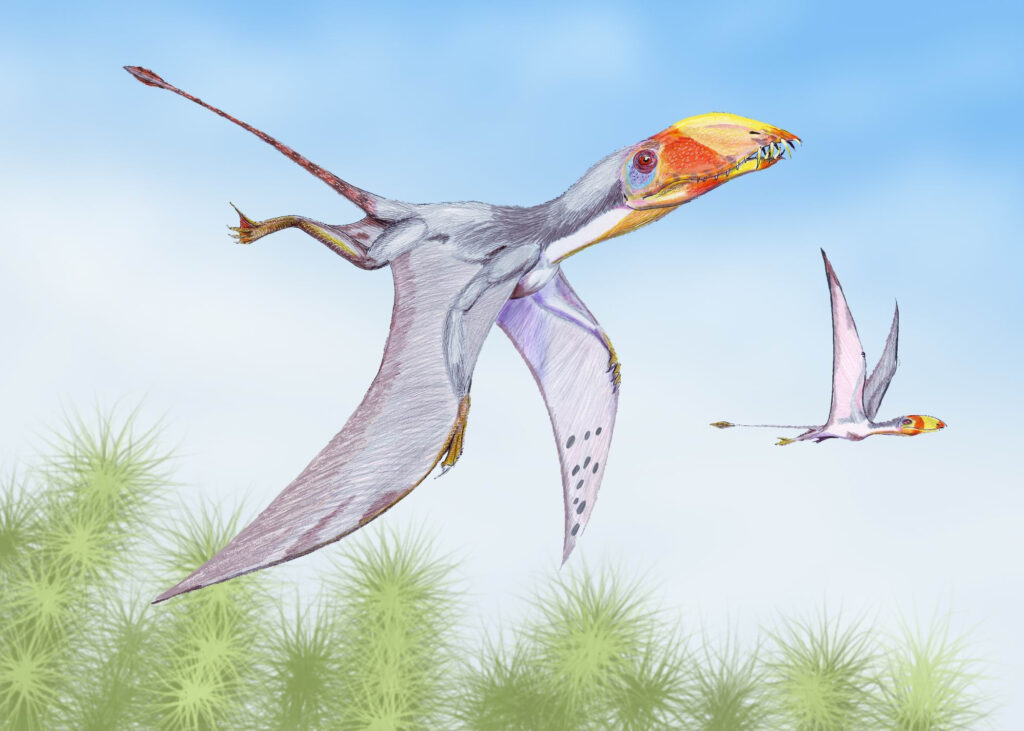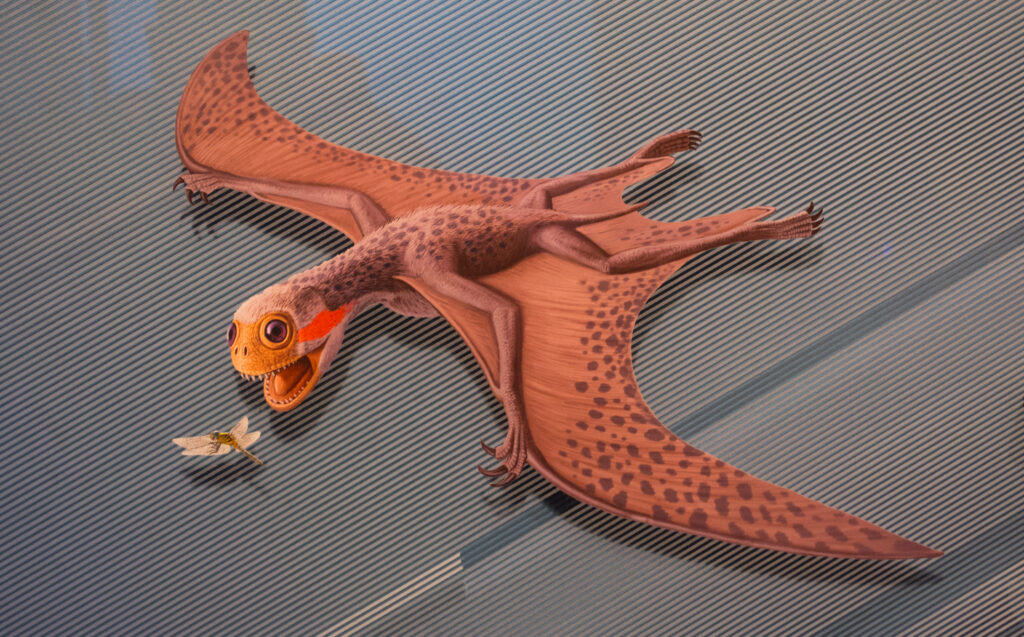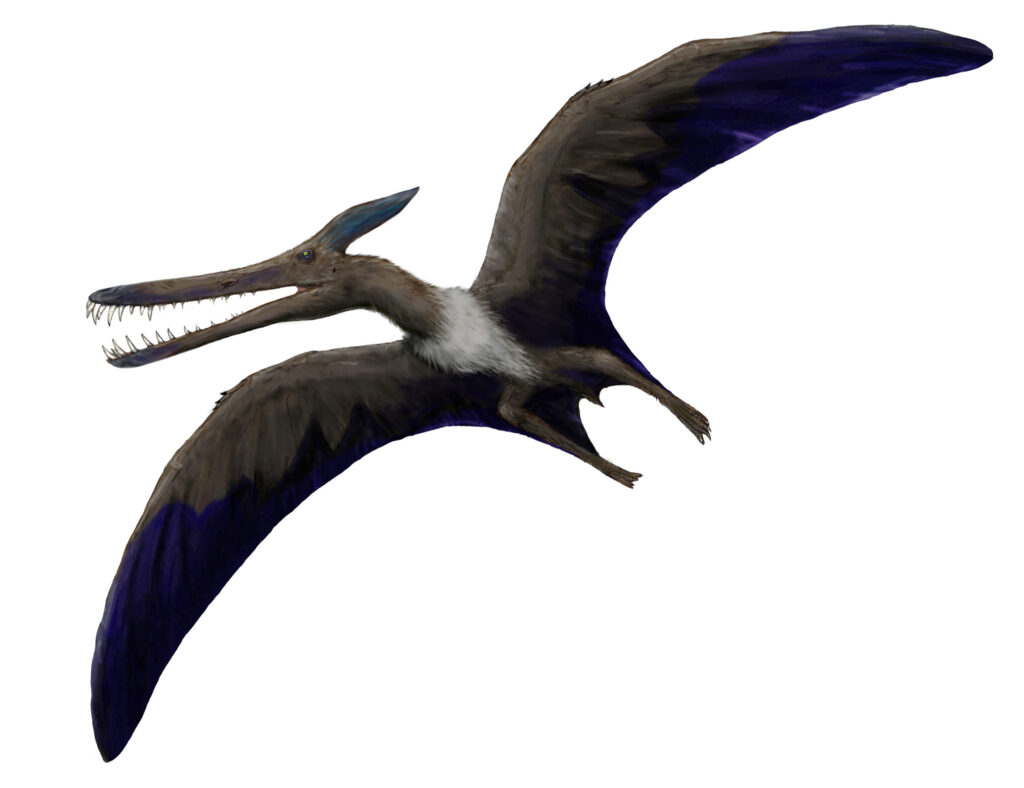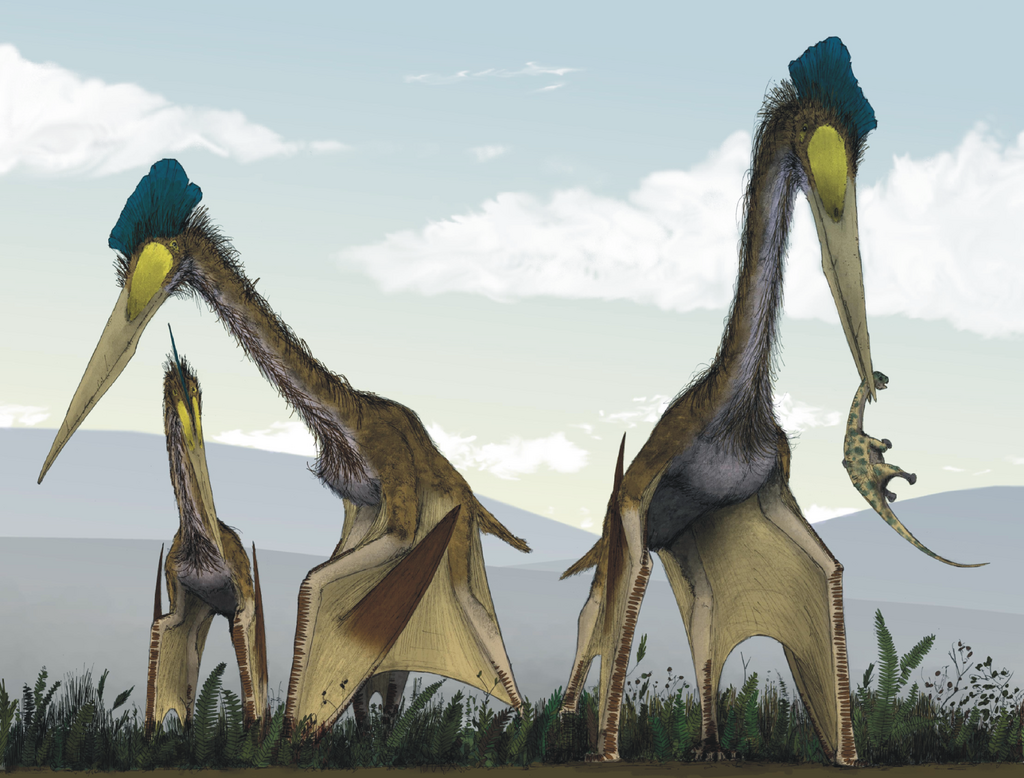When we imagine prehistoric skies, the silhouettes of pterosaurs—with their leathery wings stretched wide—often come to mind. These remarkable flying reptiles dominated the air while dinosaurs ruled the land, yet they remain widely misunderstood. Despite their frequent portrayal as “flying dinosaurs” in popular media, pterosaurs were distinctly different creatures with their own evolutionary path and specialized adaptations. This fascinating group of reptiles, the first vertebrates to evolve powered flight, inhabited Earth for over 150 million years before disappearing alongside non-avian dinosaurs in the mass extinction event at the end of the Cretaceous period. Their unique anatomy, diverse species, and evolutionary innovations make them one of the most extraordinary groups of animals ever to have lived on our planet.
Not Dinosaurs: The Taxonomic Distinction

The first and most fundamental point to understand about pterosaurs is that they were not dinosaurs, despite common misconceptions. Both groups belong to the larger classification of archosaurs, making them cousins rather than the same family. Dinosaurs fall within the group Dinosauria, which includes two major branches: Ornithischia (bird-hipped dinosaurs like Stegosaurus) and Saurischia (lizard-hipped dinosaurs, including both sauropods and theropods, from which birds evolved). Pterosaurs, in contrast, belong to their distinct archosaur group called Pterosauria. They shared a common ancestor with dinosaurs over 245 million years ago, but then followed a separate evolutionary trajectory. This taxonomic distinction means that despite living alongside dinosaurs, pterosaurs represent an entirely different reptilian experiment in evolution, one that conquered the skies through their unique adaptations.
Masters of Flight: The Wing Structure

Pterosaur wings represent one of the most sophisticated flight adaptations in vertebrate history, fundamentally different from those of birds or bats. The primary flight membrane, called the patagium, stretched from an enormously elongated fourth finger to the body and hind limbs. This membrane wasn’t simply skin—it contained complex structural fibers called actinofibrils that provided strength, shape control, and prevented tearing. Unlike bird wings supported by multiple fingers and feathers, the pterosaur’s entire wing structure depended on this single, hyper-elongated digit—an extraordinary evolutionary solution to the challenge of flight. Advanced pterosaurs also developed a unique wrist bone called the pteroid, which controlled a small membrane (propatagium) at the front of the wing, enhancing flight control. Microscopic studies of preserved wing membranes reveal they were also equipped with blood vessels, muscles, and possible insulating fuzz, making them sophisticated, living aerodynamic surfaces rather than simple skin flaps.
Lightweight Champions: The Hollow Bone Revolution

Pterosaurs achieved remarkable flight efficiency through their extraordinarily lightweight skeletal structure, perhaps the most pneumatic (air-filled) bones of any vertebrate group. Their bones weren’t just hollow like birds’; they were constructed with an intricate internal network of air spaces separated by thin struts, creating maximum strength with minimal weight. This pneumatization extended throughout most of their skeleton, including the skull, vertebrae, limbs, and even portions of the pelvis in advanced species. The walls of pterosaur bones were often thinner than a sheet of paper, sometimes mere fractions of a millimeter thick in larger species. This extreme adaptation allowed giants like Quetzalcoatlus, with a wingspan comparable to a small airplane (up to 10-11 meters), to achieve flight despite their size. The hollowness was connected to an efficient respiratory system similar to birds, with air sacs that extended from the lungs into the bones, making their entire bodies optimized for the energetic demands of powered flight.
The Remarkable Pterosaur Brain

Pterosaurs possessed surprisingly sophisticated brains that reflected their complex aerial lifestyle and sensory requirements. CT scans of pterosaur skulls have revealed enlarged brain regions associated with vision, balance, and coordination—critical faculties for flying animals. The flocculus, a brain region responsible for processing information from the inner ear about spatial orientation, was particularly well-developed, suggesting they had exceptional control and awareness during flight maneuvers. Their cerebral hemispheres were also significantly expanded compared to most reptiles, hinting at higher cognitive capabilities than previously assumed. Perhaps most intriguing were their enormous optic lobes, indicating excellent vision that would have been crucial for aerial hunting and navigation. This neural architecture, combined with large eyes and semicircular canals specialized for detecting motion, created an animal neurologically equipped for the challenges of life in three-dimensional space, processing visual landscapes at high speeds while maintaining precise control of their wings.
Size Range: From Sparrows to Small Aircraft

One of the most remarkable aspects of pterosaur evolution was their extraordinary size range, spanning from tiny insect-hunters to the largest flying animals ever known. The smallest pterosaurs, like Nemicolopterus from China, had wingspans of just 25-30 centimeters (10-12 inches), roughly comparable to a modern sparrow. At the opposite extreme, giants like Quetzalcoatlus northropi and Hatzegopteryx thambema achieved wingspans estimated between 10-11 meters (33-36 feet)—dimensions approaching those of a small aircraft. This dramatic size variation represented different ecological niches and feeding strategies. The smaller pterosaurs likely darted through forests catching insects, while the largest were probably capable of soaring across continents using thermal updrafts, possibly going days without flapping. This massive size disparity, evolving over 150 million years, showcases pterosaurs’ adaptability and the various ways their unique body plan could be modified to exploit different aerial ecological opportunities throughout the Mesozoic Era.
The Bizarre Headgear: Crests and Their Functions

Among pterosaurs’ most visually striking features were their elaborate head crests, which varied dramatically across species in size, shape, and composition. These ranged from the tall, sail-like crest of Pteranodon to the extraordinary backward-sweeping crest of Nyctosaurus, which resembled an antler or branch, to the massive, boat-shaped crests of Tupandactylus. Unlike many dinosaur ornaments, pterosaur crests weren’t solely bony structures; many incorporated soft tissue extensions that dramatically increased their size and visual impact. The functions of these extravagant structures have been debated extensively, with evidence pointing to multiple purposes. Sexual display seems to be a primary function, with larger, more elaborate crests typically found in what are presumed to be males. However, biomechanical studies suggest some crests may have also served as rudders for steering during flight, thermal regulators, or species-recognition signals. Some pterosaurs, like Tapejara, had crests positioned in ways that might have improved their aerodynamics, reducing drag or increasing stability during different flight modes.
Evolutionary Pioneers: The First Vertebrate Flyers

Pterosaurs hold the distinguished evolutionary title of being the first vertebrates to evolve powered flight, beating both birds and bats to the skies by tens of millions of years. Their flight adaptation appeared approximately 228 million years ago during the late Triassic period, when early species like Eudimorphodon already displayed the key wing structure that would define the group. This innovation represented an entirely new locomotor strategy for vertebrates, opening the aerial environment as a habitat and resource space untapped by other large animals. The evolutionary pathway pterosaurs took to achieve flight remains somewhat mysterious, though most paleontologists favor a “ground-up” model where small, agile reptiles began leaping and gliding before evolving true powered flight. What makes their achievement particularly remarkable is that they evolved flight independently from birds and bats, representing a third distinct solution to the challenge of aerial locomotion among vertebrates. Their success is evidenced by their 150+ million years of aerial dominance, during which they diversified into dozens of families and hundreds of species across every continent.
Life on Land: The Quadrupedal Stance

Pterosaurs weren’t merely aerial specialists; they had sophisticated adaptations for life on the ground that differed considerably from other reptiles. Unlike the bipedal stance of many dinosaurs, pterosaurs moved quadrupedally, walking on all four limbs with a distinctive gait. Their front limbs were oriented differently from modern quadrupeds, with the wing finger folded back and the three small inner fingers bearing weight. Trackway fossils reveal they didn’t sprawl like lizards but maintained an erect posture more similar to mammals. Advanced pterosaurs like pterodactyloids showed remarkable terrestrial adaptations, including elongated metacarpals that effectively functioned as part of the forearm, giving them a distinctive walking profile. Some species, particularly the massive azhdarchids like Quetzalcoatlus, appear to have been highly proficient on land, with limb proportions suggesting they could walk efficiently and perhaps even run when necessary. This terrestrial capability challenges older notions that pterosaurs were awkward on the ground and suggests many species may have spent significant time foraging terrestrially, similar to modern storks or ground hornbills.
The Fuzzy Revolution: Pterosaur Integument

One of the most groundbreaking discoveries in pterosaur research has been the identification of their body covering, not scales as traditionally depicted, but a fuzzy coat of hair-like structures called pycnofibers. Unlike the feathers of birds, which develop from follicles, these filaments appear to have been unique structures that evolved independently. Exquisitely preserved fossils, particularly from Brazil’s Crato Formation and China’s Jehol Biota, show these filaments covered much of the body, varying in length and density between species. Some pterosaurs had short, dense fuzz resembling modern mammalian fur, while others displayed longer, possibly more specialized filaments. This insulating layer would have been crucial for maintaining body temperature in active flying animals with high metabolic needs. The presence of this fuzzy covering has profound implications for pterosaur physiology, suggesting they were endothermic (warm-blooded) like modern birds and mammals rather than ectothermic like most reptiles. This integumentary revolution has transformed our visualization of these animals from leathery, bat-like creatures to more dynamic, fuzzy animals that would have appeared quite unlike any living reptile.
Diverse Feeding Adaptations: Beaks, Teeth, and Diets

Pterosaurs evolved an astonishing array of feeding adaptations across their long evolutionary history, reflecting diverse ecological niches spanning terrestrial and marine environments. Early pterosaurs typically possessed numerous small, sharp teeth ideal for catching fish or insects. As they diversified, specialized dentition emerged—Rhamphorhynchus developed long, forward-pointing teeth that functioned like a fish trap, while Dsungaripterus evolved robust, rounded teeth specialized for crushing hard-shelled prey like mollusks. Perhaps most remarkable was the transition in many lineages to completely toothless beaks, paralleling modern birds. These beaks came in numerous specialized forms: the needle-like beaks of Pteranodon for spearing fish, the massive, boat-shaped bills of Thalassodromeus possibly used for skimming prey from water surfaces, and the stork-like beaks of azhdarchids for terrestrial predation. Some pterosaurs, like the bizarre Pterodaustro, developed an extraordinary filter-feeding apparatus with over 1,000 bristle-like teeth resembling baleen. These diverse feeding adaptations demonstrate pterosaurs’ remarkable ecological versatility and explain how different species could coexist by exploiting different food resources, from tiny crustaceans to small vertebrates.
Pterosaur Reproduction: Eggs, Hatchlings, and Parental Care

Our understanding of pterosaur reproduction has been revolutionized by remarkable fossil discoveries from the past two decades, overturning many previous assumptions. Unlike reptilian eggs with leathery shells, pterosaur eggs had parchment-like, minimally mineralized shells similar to those of some modern lizards. This soft-shelled nature suggests they were likely buried in soil or vegetation rather than incubated in open nests. Embryonic pterosaur fossils reveal that hatchlings emerged with well-developed wing bones, suggesting they might have been capable of flight shortly after hatching—a precocial development strategy. However, other evidence indicates some species may have required extended parental care. The proportions of pterosaur hatchlings differed from adults, with relatively shorter wings and larger heads, suggesting their flight capabilities and feeding strategies might have changed as they matured. Intriguingly, some pterosaur fossils from Brazil have been found in large concentrations, potentially representing colonial nesting grounds similar to modern seabirds. These discoveries hint at complex reproductive behaviors that may have included some form of parental investment, challenging older notions of pterosaurs as reptiles that simply laid eggs and abandoned their young.
The Evolutionary Endgame: Why Did Pterosaurs Disappear?

The extinction of pterosaurs coincided with the end-Cretaceous mass extinction event approximately 66 million years ago, which also claimed the non-avian dinosaurs and numerous other groups. The impact of the Chicxulub asteroid in Mexico’s Yucatán Peninsula triggered catastrophic global changes, including wildfires, temperature fluctuations, acid rain, and darkened skies that disrupted photosynthesis. These conditions would have been particularly devastating for pterosaurs, whose flying lifestyle depended on abundant food resources and stable atmospheric conditions. By the late Cretaceous, pterosaur diversity had already declined significantly from its earlier peaks, with only a few specialized groups like the azhdarchids and nyctosaurids persisting. This reduction may reflect competition with the increasingly diverse birds, which had been evolving since the Jurassic and occupied many small-bodied flying niches. The final pterosaurs were predominantly large-bodied species with specialized feeding adaptations, making them particularly vulnerable to ecosystem collapse. Their extinction left birds as the sole vertebrate aerial specialists, a position they continue to hold today. The pterosaur evolutionary experiment, spanning over 150 million years and producing some of the most remarkable flying creatures in Earth’s history, thus came to an abrupt end alongside the dinosaurian dynasty they had accompanied throughout the Mesozoic Era.
Modern Research: How We Study Pterosaurs Today

Pterosaur research has undergone a renaissance in recent decades, transformed by new fossils, technologies, and analytical approaches. Computer tomography (CT) scanning now allows scientists to examine the internal structures of pterosaur bones and skulls without damaging specimens, revealing details about brain anatomy, sensory capabilities, and bone architecture previously impossible to study. Advances in biomechanical modeling, using engineering principles and computer simulations, have revolutionized our understanding of pterosaur flight capabilities, showing how different species might have launched, soared, and landed. Exceptional preservation sites discovered in Brazil, China, and Germany have yielded specimens with soft tissues intact, including wing membranes, throat pouches, and pycnofibers, dramatically improving our ability to reconstruct their appearance and biology. Discoveries continue at an accelerating pace, with approximately 15-20 new pterosaur species named annually, constantly refining our understanding of their diversity and evolutionary relationships. Modern techniques like scanning electron microscopy have revealed microscopic details of pterosaur wing membranes and pycnofibers, while stable isotope analysis of their teeth provides insights into their diets and ecological roles. These scientific advances have transformed pterosaurs from mysterious, poorly understood creatures to one of the most intensively studied extinct animal groups, though countless questions about their biology and evolution remain to be answered.

Pterosaurs represent one of evolution’s most spectacular success stories—vertebrates that conquered the skies through unique adaptations distinct from the flight strategies of birds or bats. Their remarkable 150-million-year reign showcased nature’s capacity for producing extraordinary specialized forms, from tiny insectivores to giants with wingspans exceeding 30 feet. Far from being “flying dinosaurs,” pterosaurs were their distinctive branch on the reptilian evolutionary tree, developing hollow bones, sophisticated brains, insulating body coverings, and complex reproductive strategies that challenge traditional views of reptilian limitations. As paleontological techniques continue to advance, our understanding of these extraordinary animals grows increasingly nuanced, revealing them as dynamic, diverse creatures that dominated ancient skies through a combination of evolutionary innovations unseen in any living animal. In studying pterosaurs, we glimpse not just fascinating prehistoric creatures, but an entire alternative pathway of vertebrate aerial adaptation—an evolutionary experiment that succeeded brilliantly for millions of years




